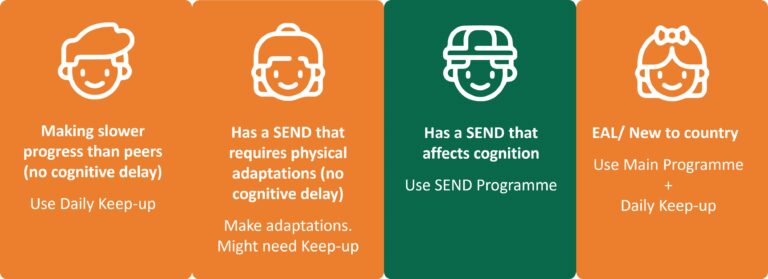In KS1 it’s imperative that we put maths into a practical perspective. Giving little ones maths in written form is too abstract and detaches them from the understanding of using maths in the real world. There are many ways to enrich KS1 maths with games and here we bring you some of our favourites:
Activity One: Adding and Subtraction Staircases
Suitable for: Rec to Year 2
Learning Focus:
- To be able to count on and back in units
- To recognise that adding increases the sizes of a number whilst subtracting decreases it
You can do this activity simply using a drawn staircase on the board or a big sheet of paper but doing it with folded card is more fun and practical. Initially number the steps to make it easier but have a second unnumbered staircase or cover up the numbers on the first for extension work.
Use plastic toy people if available and stand one on one of the steps. Ask the pupils how many steps up the staircase, the person is at. Now ask them to say how many steps up they want that person to go. Count on that number and ask them to read the number of the step. Write this as a sum on the board e.g.
Starts on third step, moves up five steps and is now on step eight
3 + 5 = 8
Repeat this until the pupils understand the principle
You can use the same staircase for subtraction. This time the plastic toy moves down the staircase but the principle is the same.
Draw staircases in their books or together make individual 3D ones to help with addition and subtraction in lessons.
You could suggest they practise this exercise on the staircase at home with suitable supervision.
Activity Two: Darts
Suitable for: Rec to Year 2
Learning Focus:
- To be able to count on and back in units
- To recognise that adding increases the size of a number whilst subtracting decreases it
For this activity you’ll need to have a Velcro darts set or you can make your own. For your own, cut out a circle and divide it into eighths. Number each according to your planning – possibly including a ‘double’ ring so the more able children can practise doubling.
Use Velcro strips on the board and stick the corresponding Velcro pieces to table tennis balls.
You can ask the pupils playing it to add up their scores to a winning number or count back from a number to zero (using subtraction). They can try their skill to hit a number to get them exactly to the winning number or, for the reducing balance game. you may head into negative numbers!
Activity Three: Smartie Fractions
Suitable for: Rec to Year 2
Learning Focus:
- Be able to find a fraction of a number
- Understand and make simple fractions, halves and quarters
Learning about fractions is far more fun when there’s the potential to eat your answers! Using smarties enables the pupils to make fractions using the different colours and then find out the fraction of a number.
Give the pupils eight smarties, four or one colour, say red, and two each of two other colours, perhaps blue and green. Tel them that halving a number means sharing it between two whilst quartering means sharing into four groups. You can give out blank fraction grids to help the strugglers. Ask them what fraction of the smarties are red, blue, not red and as an extension, not blue or not green.
Using this information ask them to say how many smarties a quarter, a half or three quarters is equal to and write out the sums . . .
Ask them if they can see what sum has been done for the answers to the first two and how that relates to the third sum. If you want to extend the activity for older or more able students, ask them to eat two of the smarties and redo the activity now with six and introduce thirds.
Activity Four: What Can I Do In . . .?
Suitable for: Rec to Year 2
Learning Focus:
- Recognise and use the different units of time
- Be able to estimate periods of time by what they could do in it
Time is a tricky topic, especially in trying to understand its duration. In this activity, the pupils get an idea of duration by thinking about what they might be able to do in different time periods.
Ask the children how long is a second, a minute, an hour or a day and you’ll possibly get some confusion as they struggle to relate it to anything other than other time units. Ask them what they think they can do in that time and the challenge is on, a challenge that will help them understand how long those periods of time are.
Challenges can include how many letters or words can they say in a second, how far can they run in ten seconds (compare with top athletes), how many pages of a book can they read or how many sums can they do in a minute.
For periods of time such as ten seconds through to five minutes, it’s worth getting them to sit quietly and consider the time period passing – putting up their hands when they think the time is up.
Considering time is also a good lead in to PSHE work on whether we make the best use of our time. What help could I give someone in five minutes or half an hour is perhaps a good question.
For a fun conclusion to this activity, get them to think of wacky things to do in the time e.g.
I could wash an elephant in ten minutes, I could eat a doughnut in 30 seconds.






